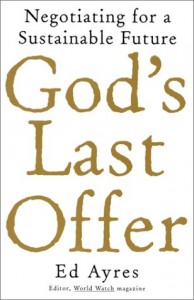God’s Last Offer
Jan 01
 God’s Last Offer, by Ed Ayers a World Watch editor, published in 2000 would seem to be a dated piece of writing, but in the end it is still relevant today. Explaining in detail the threat of global warming, climate change and environmental degradation, Ayers uses many examples to make his point about the threats that were all around us then and which much of America was only mildly interested in at the turn of the century, and now 10 years later still struggles to find universal support.
God’s Last Offer, by Ed Ayers a World Watch editor, published in 2000 would seem to be a dated piece of writing, but in the end it is still relevant today. Explaining in detail the threat of global warming, climate change and environmental degradation, Ayers uses many examples to make his point about the threats that were all around us then and which much of America was only mildly interested in at the turn of the century, and now 10 years later still struggles to find universal support.
The title itself is an emotional indicator for Ayers that we have only so much time to remedy many of the problems he so ably describes. Dividing the threats into four categories of what he calls worldwide spikes: The Carbon Dioxide Spike – The Extinction Spike – The Consumption Spike – The Population Spike. His simple but compelling graphs outlining the profile and acceleration of these spikes are a quick study of just how much impact and change has gone in the last few hundreds of years. He then continues on to use worldwide examples to illustrate the environmental degradation and destruction that has brought us to the precipice of disaster.
This is a book that cannot be denied, but yet it still has the feel of ultimately only being read by people that already know or are already “true believers”. No one can question the author’s passion and research surrounding his many examples, but in the end many doubters will put the book down after being bombarded by statistics that tend after while to disengage the reader rather than engage. That is not necessarily a criticism of the author, but a statement of the attitudes that many will bring to books with this message seeking more information, but then giving up when any attempts at solutions seem too overwhelming.
Unfortunately many will say that after 10 years much of his examples have not come to pass but that only means that technology has staved off for a short period of time the inevitable outcomes that bode poorly for our continued survival.
My real criticism of his book is its inability to give real meaning to just how important the Population Spike is tied to the other three spikes, and the myriad of problems that emanate and dramatically escalate because of exploding population growth, particularly in the last 50 years. It is critical that all readers be reminded that all the environmental problems that exist today have been brought on by our lack of foresight in controlling mankind’s tendency to overpopulation, over-consumption and decimate that which is central to our very existence.
But in the end the author leaves us with what he believes is the last hope:
Ironically, it can be only through our acceptance of this offer – to defend our world instead of ourselves – that we have any real chance of saving ourselves and of regaining the sense of personal and family security we care about so deeply.
It would be difficult to argue against that final summary.
